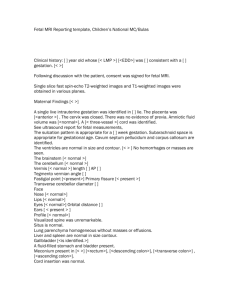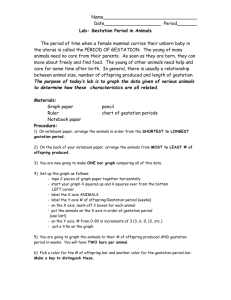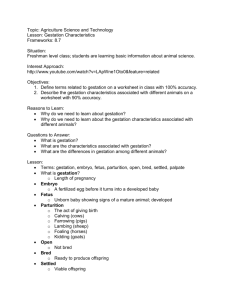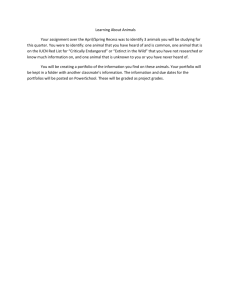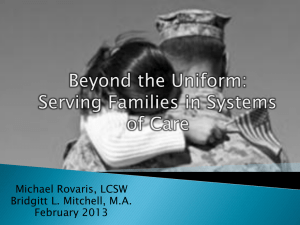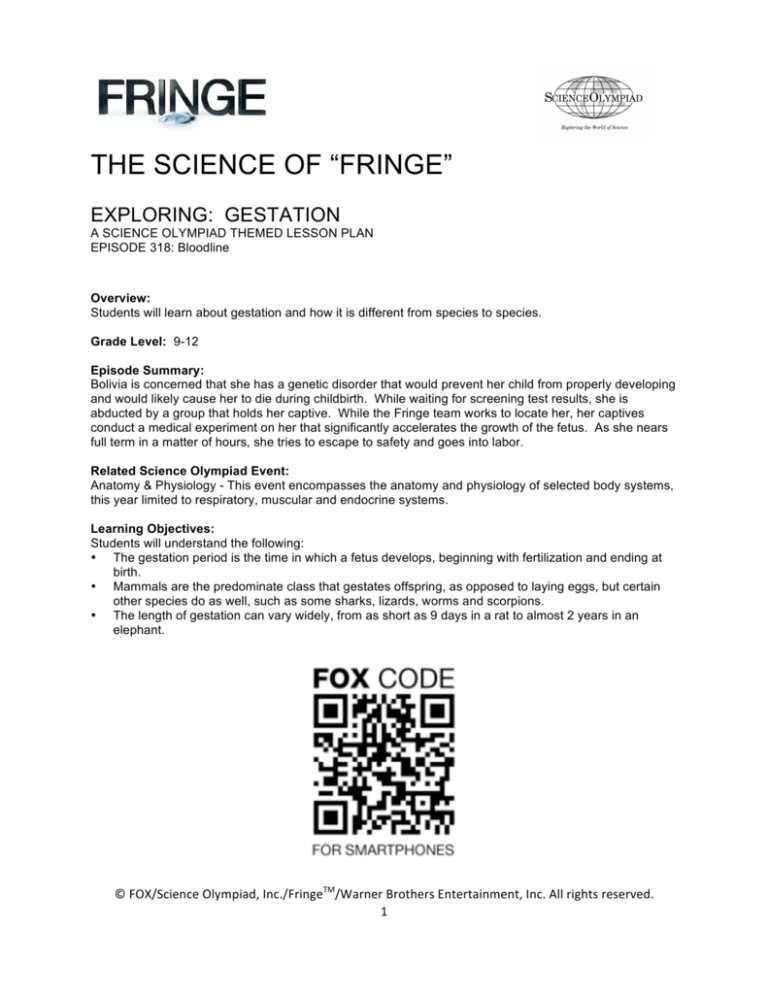
THE SCIENCE OF “FRINGE”
EXPLORING: GESTATION
A SCIENCE OLYMPIAD THEMED LESSON PLAN
EPISODE 318: Bloodline
Overview:
Students will learn about gestation and how it is different from species to species.
Grade Level: 9-12
Episode Summary:
Bolivia is concerned that she has a genetic disorder that would prevent her child from properly developing
and would likely cause her to die during childbirth. While waiting for screening test results, she is
abducted by a group that holds her captive. While the Fringe team works to locate her, her captives
conduct a medical experiment on her that significantly accelerates the growth of the fetus. As she nears
full term in a matter of hours, she tries to escape to safety and goes into labor.
Related Science Olympiad Event:
Anatomy & Physiology - This event encompasses the anatomy and physiology of selected body systems,
this year limited to respiratory, muscular and endocrine systems.
Learning Objectives:
Students will understand the following:
• The gestation period is the time in which a fetus develops, beginning with fertilization and ending at
birth.
• Mammals are the predominate class that gestates offspring, as opposed to laying eggs, but certain
other species do as well, such as some sharks, lizards, worms and scorpions.
• The length of gestation can vary widely, from as short as 9 days in a rat to almost 2 years in an
elephant.
©
FOX/Science
Olympiad,
Inc./FringeTM/Warner
Brothers
Entertainment,
Inc.
All
rights
reserved.
1
Episode Scenes of Relevance:
• Medical staff discussing the status of Bolivia (23:59 ‘hemoglobin count’ – 24:38 ‘phase 2’)
• Bolivia calling Lincoln to rescue her (31:40 ‘agent Lee’ – 32:15 ‘can you hear me’)
Online Resources:
• Fringe “Bloodline” full episode: http://www.fox.com/watch/fringe
• Science Olympiad Anatomy and Physiology event: http://soinc.org/anatomy_physiology_c
• University of New South Wales Animal Development:
http://php.med.unsw.edu.au/embryology/index.php?title=Animal_Development
• Wikipedia page on Gestation: http://en.wikipedia.org/wiki/Gestation
• San Jose State University Gestation Periods analysis: http://www.applet-magic.com/gestation.htm
Procedures:
1. Tell your students that they are going to learn about gestation and how it is different in various
species.
2. Have your students research gestation in resources such as biology textbooks and websites and
discuss what they have learned.
3. Divide your class into small groups. Have each group complete the following activity:
a. Materials: computer with internet access or resource books, paper, calculators
b. Search online or in the resource books for information about the gestation of various mammal
species.
c. Create a spreadsheet documenting the average gestation period along with other typical
characteristics of the species such as size, weight, longevity.
d. Analyze the data to determine if length of gestation is correlated to any other general physical
characteristic.
e. Make a graph showing the correlation.
4. Discuss with the class the results of the activity. Be sure to address:
a. Which physical characteristic of an animal is most correlated to gestation period? Which is
least correlated?
b. What evolutionary reason might be the cause for such a correlation?
c. Where does the human gestation period fall relative to the range of periods researched?
Additional Discussion Suggestions:
• How do the range of gestation periods compare to the range of incubation periods for animals that lay
eggs?
• The gestation is typically divided into two main phases: differentiation and development (growth).
Based upon those descriptions, what processes are fetuses undergoing during these phases?
• Some mammals gestate multiple fetuses at the same time (litters) while others typically only have
single births. Why would one method be beneficial over the other?
Extension to Other Subjects:
Literature: Occasionally a specific zoo animal gives birth to offspring, which makes national news.
Research some of the recent cases of this and discuss how the media portrayed the gestation period and
outcome.
©
FOX/Science
Olympiad,
Inc./FringeTM/Warner
Brothers
Entertainment,
Inc.
All
rights
reserved.
2
Social Studies: Pregnancy rates vary significantly throughout the world. Research the range of rates for
several countries and analyze what societal features might lead to those rates.
History: Newborn and maternal fatality rates have dropped significantly over recent years due to
improvements in health care and prenatal care. Research some of the advances that have led to this
improvement.
National Science Standards Alignment:
C. Structure and function in living systems
M.C.1 Structure and function in living systems
e. The human organism has systems for digestion, respiration, reproduction, circulation,
excretion, movement, control, and coordination, and for protection from disease. These systems
interact with one another.
©
FOX/Science
Olympiad,
Inc./FringeTM/Warner
Brothers
Entertainment,
Inc.
All
rights
reserved.
3


